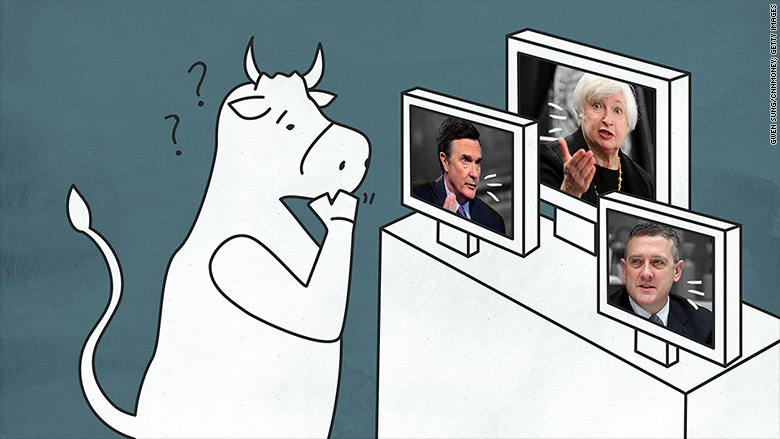
The Federal Reserve is sending mixed messages to the stock market.
Fed Chair Janet Yellen seemed worried last week about the weakening global economic outlook, saying: "The situation abroad bears close watching." It signaled a "dovish" or cautious approach to the timing on lifting the Fed's benchmark interest rates from zero.
In the days since then she's been contradicted several times by "hawkish" Fed presidents who want to raise interest rates sooner rather than later.
Stock market investors have struggled to understand the reasons behind the Fed's decision not to raise rates on Thursday and also to predict exactly when rates will rise.
The Dow fell almost 300 points Friday, before rising a little on Monday and then again falling over 180 points Tuesday. With other bad news -- Volkswagen's emissions scandal, China fears -- already in the mix, heightened Fed uncertainty adds pressure on markets.
Uncertainty is exactly the opposite of what the Fed's leaders want to see. But now some investors are dubbing this the "dazed and confused" market (bring on the Matthew McConaughey jokes).
Here's a timeline on the Fed's confusing signals and how we got here.
Related: Meet Janet Yellen: the most powerful woman in the world
Thursday September 17: No rate hike on global fears
Fed Chair Janet Yellen announced that the Fed wouldn't raise its key interest rate. Even though the Fed is optimistic about the U.S. economy, she cited the global economic slowdown and volatile stock markets as reasons to wait on the first rate hike in almost a decade.
Yellen said: "Heightened concerns about growth in China and other emerging market economies have led to notable volatility in financial markets."
Related: No liftoff: Fed keeps rates at zero
Saturday September 19: Rate hike decision was a "close call"
Two days after Yellen spoke, San Francisco Fed President John Williams -- a Fed committee voting member this year -- said the decision against a rate hike was a "close call."
That goes against the Fed's official statement, which shows 9 out of 10 members voted against a rate hike. The only dissenter was Jeffrey Lacker, the Richmond Fed President who wanted to do a rate hike.
Williams argued on Saturday that the U.S. economy's performance didn't warrant near-zero interest rates.
"The economy has come a long way since the dark days of late 2009," Williams said. "We're in a very different place now than when we first instituted extremely accommodative policy."
Related: The Fed is handcuffing itself. Here's how.
Monday September 21: "I thought it was time to move"
Williams wasn't the only one to modestly break away from Yellen's cautious tone.
After speaking at an event in Tennessee on Saturday, St. Louis Fed President argued FOR a rate hike on CNBC Monday morning. Bullard doesn't have a vote, but he will next year, and he said he would've dissented against the Fed's decision last week.
"There is a powerful case to be made that it's time to normalize interest rates," Bullard said. "I thought it was time to move."
Later Monday, Atlanta Fed President Andrew Lockhart said a rate hike in 2015 is still likely in his view -- as long as stock markets calm down.
"As things settle down, I will be ready for the first policy move on the path to a more normal interest-rate environment," Lockhart said.
The Fed's leaders aren't done talking either.
Lockhart speaks Wednesday, Yellen has a speech scheduled for Thursday and Bullard speaks for a third time on Friday, according to Bespoke Investment Group.


